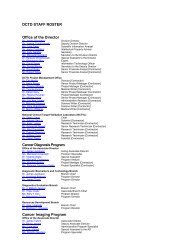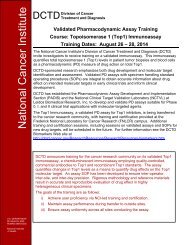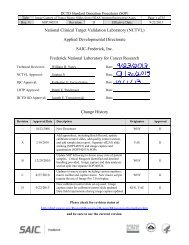National Cancer Institute - NCI Division of Cancer Treatment and ...
National Cancer Institute - NCI Division of Cancer Treatment and ...
National Cancer Institute - NCI Division of Cancer Treatment and ...
You also want an ePaper? Increase the reach of your titles
YUMPU automatically turns print PDFs into web optimized ePapers that Google loves.
C U R R E N T F U N D I N G O P P O R T U N I T I E S<br />
Phased Application Awards in<br />
<strong>Cancer</strong> Prognosis <strong>and</strong> Prediction<br />
Program Announcement:<br />
PA-04-102: http://grants.nih.gov/grants/<br />
guide/pa-files/PA-04-102.html<br />
(expiration date 11/2/2006)<br />
Contacts:<br />
Tracy Lively, Ph.D.<br />
301-496-1591, livelyt@mail.nih.gov<br />
Magdalena Thurin, Ph.D.<br />
301-496-1591, thurinm@mail.nih.gov<br />
James V. Tricoli, Ph.D.<br />
301-496-1591, tricolij@mail.nih.gov<br />
An increasing number <strong>of</strong> publications<br />
have described new molecules, new<br />
patterns <strong>of</strong> gene expression, <strong>and</strong> new<br />
aspects <strong>of</strong> tumor cell growth that seem<br />
to be correlated with known prognostic<br />
factors. However, studies that go beyond<br />
the exploratory stage <strong>of</strong> developing a<br />
new diagnostic test require large numbers<br />
<strong>of</strong> patient samples with associated clinical<br />
data. They also need an efficient assay<br />
technique <strong>and</strong> a great deal <strong>of</strong> statistical<br />
input. Such tools could improve clinical<br />
decision-making in the care <strong>of</strong> cancer<br />
patients.<br />
This CDP-sponsored program is accelerating<br />
the translation <strong>of</strong> new discoveries into<br />
clinical practice by allowing investigators<br />
to use new diagnostic strategies to solve<br />
clinical problems. By providing up to five<br />
years <strong>of</strong> support for a first phase grant<br />
(R21) for technical development <strong>and</strong> a<br />
second phase grant (R33) for application<br />
<strong>and</strong> evaluation <strong>of</strong> clinical utility, CDP will<br />
enable investigators to evaluate the utility<br />
<strong>and</strong> pilot the application <strong>of</strong> new strategies<br />
for determining prognosis or predicting<br />
response to therapy.<br />
34 ■ P R O G R A M A C C O M P L I S H M E N T S 2 0 0 6<br />
Exploratory Studies in<br />
<strong>Cancer</strong> Detection, Diagnosis,<br />
<strong>and</strong> Prognosis<br />
Program Announcement:<br />
PA-05-165: http://grants.nih.gov/grants/<br />
guide/pa-files/PA-05-165.html<br />
(expiration date 11/2/2008)<br />
Contact:<br />
James V. Tricoli, Ph.D.<br />
301-496-1591, tricolij@mail.nih.gov<br />
Advances in the underst<strong>and</strong>ing <strong>of</strong><br />
basic cancer biology <strong>and</strong> the development<br />
<strong>of</strong> powerful molecular technologies<br />
are leading to the identification <strong>of</strong> many<br />
new abnormalities in precancerous <strong>and</strong><br />
cancer cells. New biomarkers <strong>and</strong> laboratory<br />
assays are needed to screen patients<br />
for cancer <strong>and</strong> assess their risk. These<br />
biomarkers could also be used to assess<br />
disease prognosis <strong>and</strong> response to<br />
cancer treatments, especially new<br />
treatments.<br />
The major goal <strong>of</strong> this CDP initiative is<br />
to promote the initial evaluation <strong>of</strong> new<br />
molecular or cellular characteristics <strong>of</strong><br />
premalignant cells or tumors or the development<br />
<strong>of</strong> assays that will be useful for<br />
cancer detection, diagnosis, <strong>and</strong> prognosis.<br />
Using the exploratory/developmental<br />
grant (R21) mechanism, this initiative will<br />
provide up to two years <strong>of</strong> support for<br />
translational studies that identify promising<br />
new means for cancer detection <strong>and</strong><br />
diagnosis <strong>and</strong> provide the initial, critical<br />
information needed to decide whether<br />
potential clinical utility justifies further<br />
investment.










